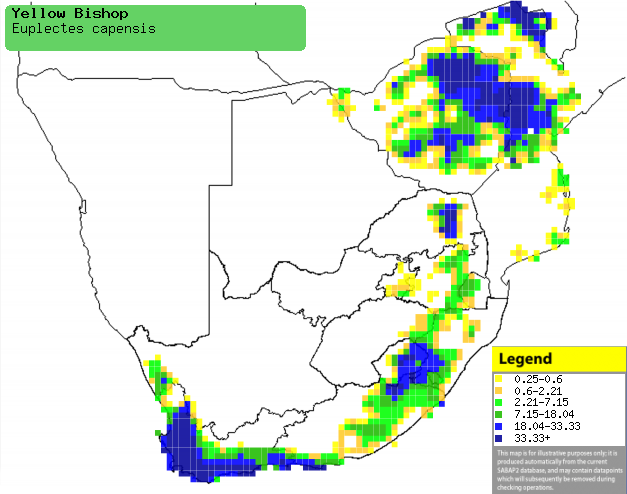|
Euplectes capensis (Yellow
bishop, Cape Bishop, Cape Widow, Yellow-rumped widow)
Kaapse flap [Afrikaans]; Isahomba, Isakhomba
(terms applied to Fan-tailed widowbird) [Xhosa]; Enzunge (applied to some
of the bishops, widows and sparrows) [Kwangali]; Thaha (generic term for
bishops and queleas) [South Sotho]; Mantunje, Xikhungumala [Tsonga];
Fluweelwidavink [Dutch]; Euplecte à croupion jaune [French]; Samtweber
[German]; Cardeal-tecelão-de-rabadilha-amarela [Portuguese]
Life
> Eukaryotes >
Opisthokonta
> Metazoa (animals) >
Bilateria >
Deuterostomia > Chordata >
Craniata > Vertebrata (vertebrates) > Gnathostomata (jawed
vertebrates) > Teleostomi (teleost fish) > Osteichthyes (bony fish) > Class:
Sarcopterygii (lobe-finned
fish) > Stegocephalia (terrestrial
vertebrates) > Tetrapoda
(four-legged vertebrates) > Reptiliomorpha > Amniota >
Reptilia (reptiles) >
Romeriida > Diapsida > Archosauromorpha > Archosauria >
Dinosauria
(dinosaurs) > Saurischia > Theropoda (bipedal predatory dinosaurs) >
Coelurosauria > Maniraptora > Aves
(birds) >
Order: Passeriformes > Family: Ploceidae
> Genus: Euplectes
Distribution and habitat
Although it occurs in areas of Ethiopia and Nigeria, the
bulk of its population extends from Uganda and southern DRC though Tanzania,
Angola and Zambia to southern Africa. Here it is fairly common in north-central
Mozambique, Zimbabwe and in South Africa along the Escarpment, through Lesotho
and the Eastern Cape to the Western Cape. It occupies a wide array of habitats,
including fynbos, cultivated land, dense vegetation along streams, forest edges
and montane grassland.
|
 |
|
Distribution of Yellow bishop in southern Africa,
based on statistical smoothing of the records from first SA Bird Atlas
Project (©
Animal Demography unit, University of
Cape Town; smoothing by Birgit Erni and Francesca Little). Colours range
from dark blue (most common) through to yellow (least common).
See here for the latest distribution
from the SABAP2. |
Predators and parasites
It has been recorded as prey of the following animals:
Food
It eats seeds supplemented with insects, doing most of its
foraging on the ground and in patches of grass. The following food items have been recorded
in its diet:
- Seeds
- maize
- rice
- millet
- indigenous grass
- Insects
Breeding
- Polygynous solitary nester, as it may mate with at least 3-4 females in a
breeding season, defending his territory with multiple nests against
intruders, such as other Euplectes species.
- The male builds the nest, which is a domed structure with a side
entrance, made of woven strips of grass and lined by the female with grass
seed heads, which may project out of the entrance to form an untidy hood. It
is typically concealed in a dense grass tuft or shrub, the leaves of which
are often incorporated into the nest.
- Egg-laying season is mainly from December-April in summer rainfall
areas, and from August-October in places with winter rainfall.
- It lays 2-4 eggs, which are incubated solely by the female for about
15-16 days.
- The chicks are fed by the female only, leaving the nest after about
16-20 days.
Threats
Not threatened.
References
-
Hockey PAR, Dean WRJ and Ryan PG 2005. Roberts
- Birds of southern Africa, VIIth ed. The Trustees of the John Voelcker
Bird Book Fund, Cape Town.
|
